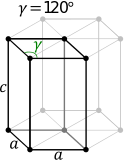Trigonal crystal system
 An example of trigonal crystals, quartz |
 An example of trigonal rhombohedral crystals, dolomite |
 Hexagonal lattice cell (P) |
 Rhombohedral lattice cell (R) |
|---|
In crystallography, the trigonal crystal system is one of the seven crystal systems. Sometimes the term rhombohedral lattice system is used as an exact synonym, whereas it is a subset. Crystals in the rhombohedral lattice system are always in the trigonal crystal system, but some crystals such as quartz are in the trigonal crystal system but not in the rhombohedral lattice system. The rhombohedral lattice system consists of the rhombohedral lattice, while the trigonal crystal system consists of the five point groups of the seven space groups with a rhombohedral lattice. There are 25 space groups whose point groups are one of the five in the trigonal crystal system, consisting of the seven space groups associated with the rhombohedral lattice system together with 18 of the 45 space groups associated with the hexagonal lattice system.
The trigonal point group describes the symmetry of an object produced by stretching a cube along the body diagonal. The resultant rhombohedral (or trigonal) Bravais lattice is generated by three primitive vectors of equal length that make equal angles with one another.[1]
"Rhombohedral crystal system" is an ambiguous term that confuses the trigonal crystal system with the rhombohedral lattice system and may mean either of them (or even the hexagonal crystal family).
In the classification into 6 crystal families, the trigonal crystal system is combined with the hexagonal crystal system and grouped into a larger hexagonal family.[2]
Rhombohedral lattice system
There are two descriptions (settings) of the rhombohedral lattice system.
- Hexagonal axes. The unit cell is a = b ≠ c; α = β = 90°, γ = 120°. Two additional lattice points occupy space diagonal of the unit cell and have coordinates 2/3 1/3 1/3 and 1/3 2/3 2/3. Hence, there are totally 3 lattice points per unit cell.
- Rhombohedral axes. The unit cell is a rhombohedron (which gives the name for rhombohedral lattice system). This is a primitive unit cell (no additional lattice points inside unit cell) with parameters a = b = c; α = β = γ ≠ 90°.
In practice, the hexagonal description is more commonly used because it is easier to deal with coordinate system with two 90° angles. However, the rhombohedral axes are often shown in textbooks because this cell reveals 3m symmetry of crystal lattice. The relation between two settings is given below.


The rhombohedral lattice system is combined with the hexagonal lattice system and grouped into a larger hexagonal family. These lattice systems belong to hexagonal family because the same (hexagonal) unit cell can be used for both of them.
Crystal classes
The trigonal crystal system is the only crystal system whose point groups have more than one lattice system associated with their space groups: the hexagonal and rhombohedral lattices both appear.
The 5 point groups in this crystal system are listed below, with their international number and notation, their space groups in name and example crystals. (All these point groups are also associated with some space groups not in the rhombohedral lattice system.)[3][2][4]
| # | Point group | Examples | Space group | ||||
|---|---|---|---|---|---|---|---|
| Class | Intl | Schoen. | Orb. | Cox. | |||
| 143-146 | Pyramidal rhombohedral tetartohedral |
3 | C3 | 33 | [3]+ | carlinite, jarosite | P3, P31, P32 R3 |
| 147-148 | Rhombohedral rhombohedral tetartohedral |
3 | S6 | 3× | [2+,6+] | dolomite, ilmenite | P3 R3 |
| 149-155 | trapezohedral | 32 | D3 | 223 | [2,3]+ | abhurite, quartz, cinnabar | P312, P321, P3112, P3121, P3212, P3221 R32 |
| 156-161 | Ditrigonal Pyramidal rhombohedral hemimorphic |
3m | C3v | *33 | [3] | schorl, cerite, tourmaline, alunite, lithium tantalate | P3m1, P31m, P3c1, P31c R3m, R3c |
| 162-167 | Hexagonal Scalenohedral rhombohedral holohedral |
3m | D3d | 2*3 | [2+,6] | antimony, hematite, corundum, calcite | P31m, P31c, P3m1, P3c1 R3m, R3c |
See also
References
- ↑ Ashcroft, Neil W.; Mermin, N. David, 1976, "Solid State Physics," 1st ed., p. 119 ISBN 0-03-083993-9
- ↑ 2.0 2.1 Hurlbut, Cornelius S.; Klein, Cornelis, 1985, Manual of Mineralogy, 20th ed., pp. 78–89 ISBN 0-471-80580-7
- ↑ Frederick H. Pough, Roger Tory Peterson (1998). A Field Guide to Rocks and Minerals. Houghton Mifflin Harcourt. p. 62. ISBN 0-395-91096-X.
- ↑ Crystallography and Minerals Arranged by Crystal Form, Webmineral
External links
| ||||||